HTML Basics: A Simple Guide for Beginners

In this beginner’s guide, we will explore the fundamentals of HTML (Hypertext Markup Language) used for creating web pages.
HTML Documents: Every HTML document begins with a declaration: <!DOCTYPE html>. The document consists of two main sections: the <head> and the <body>. The <head> contains information about the document, such as the title and character encoding, while the <body> holds the actual content.
Tags and Elements: HTML utilizes tags to define elements on a webpage. Tags are enclosed in angle brackets (<>). For example, the <h1> tag represents a heading, and the <p> tag represents a paragraph. We can nest elements inside each other to create a structured hierarchy.
Attributes: Tags can have attributes that provide additional information. Attributes are placed within the opening tag and contain a name and value. For example, the <img> tag uses the src attribute to specify the image source, and the <a> tag uses the href attribute to define a hyperlink.
Text Formatting: HTML offers various tags for text formatting. We use the <strong> tag to emphasize important text, <em> for adding emphasis, <u> to underline text, and <s> to strike through text. The <br> tag inserts line breaks, while the <hr> tag creates a horizontal rule.
Lists: HTML supports both ordered and unordered lists. The <ul> tag creates an unordered list, and the <ol> tag creates an ordered list. List items are represented by the <li> tag.
Links and Images: To create a hyperlink, we use the <a> tag with the href attribute to specify the destination URL. Images can be added using the <img> tag with the src attribute indicating the image file’s path.
Forms: HTML allows us to create interactive forms. Users can input and submit data using form elements such as <input>, <textarea>, and <select>. The <form> tag encloses the form content and specifies the destination URL for submission.
Semantic HTML: Semantic HTML gives meaning and context to the structure of a web page. Elements like <header>, <nav>, <main>, <article>, <section>, and <footer> convey the purpose of specific sections. This aids accessibility and improves search engine understanding.
CSS Integration: CSS (Cascading Style Sheets) can be used to style HTML for better visual presentation. CSS defines rules for how HTML elements should appear. We can apply styles internally using the <style> tag, externally through a separate CSS file, or inline within HTML tags.
Conclusion: HTML forms the foundation of every web page. By understanding its structure, tags, attributes, and basic elements, you can create well-organized and accessible web content. Combining HTML with CSS and other web technologies allows you to design visually appealing and engaging websites.

